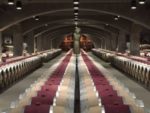The new generation, between traditions and modernity, creates delicious Japanese sakés.
Can you talk about your Kura : its history and story ?
Hiroshima, the world-known peace-memorial city, has another face. Throughout it’s history it has been well-known for sake production. In 1916, the Umeda brothers – Sawajiro and Naojiro – founded a sake brewery in the east of Hiroshima-City. They
named their product ”Honshu-Ichi”, which means ”the best in Japan”. More than 100 years later we are producing easy enjoyable and familiar Sake, with products from Hiroshima.
Our Sake has often won medals in international Sake competitions, such as IWC and Kura-Master.
Where does the name Umeda Shuzojo come from ?
”Umeda” is our family-name. And ”Shuzojo” means ”brewery”. This brewery is just a small company and a family business, so the company name is simple.
What is your vision for Japanese Saké ?
We believe that Japanese Sake surely is one of the most excellent liquors in the world. But unfortunately it is not so well known to people. In the world whomever is interested in Sake either likes it or loves it. But often they also feel Sake is mysterious, complicated, and unfamiliar. It’s maybe the same even in Japan. So we want people to touch and try Sake, and to know it’s familiar. When we drink we feel simply nice. It’s important. For that, we think, we need breweries to produce Sake, which is easy and enjoyable.
Could you talk about your sakés, do you have a signature ?
There are three main materials of Sake: rice, yeast, and water. We source them all locally from Hiroshima our home area. The rice, we mainly use Senbon-Nishiki. This rice brand is considered an original brand of Hiroshima. With this rice, it helps
us to produce sake with a rich and clear taste. As for Yeast, we mainly use Hiroshima-Ginjo Yeast. This yeast brand is also a Hiroshima original brand. With this yeast, it helps us to produce sake with a vivid and fruity aroma. And we pump up the underground water, from Mt.Iwataki, the mountain behind our brewery. About water, generally speaking, it’s softer in Japan than in Europe. And in Hiroshima, it’s an area of even softer water in Japan. From a technical point, with harder water, Sake-brewing would get somewhat easier. Because, hard water can easily melt rice
So in the past, Hiroshima was also a famous brewery area, but had some handicapped conditions in Sake-brewing. But in the Meiji era, a famous researcher MIURA Senzaburo found a Sake-brewing way with soft water. By that new way, and with some hard work we’ve been able to produce fine quality, soft and smooth Sake in Hiroshima. As I’ve said, our Sake has a rich and clear taste, and a vivid and fruity aroma. And that taste and aroma are well-balanced. Even for the people who are not familiar with Sake, our Sake can be simply fine, and easily enjoyable.
Could you give us some advice for pairing your sakés with food ?
Our Sake flavor is clear and light. So for foreigners, it’s easy to associate with White-Wines. As such, it’s easy to imagine pairing with fish dishes. For example with Sashimi or Sushi as good famous Japanese dishes. Otherwise, Meuniere or Fried fish is also good. And we often enjoy with oysters. Hiroshima is famous for oysters in Japan. But actually, our Sake aroma and taste are somewhat solid and vivid. So even with dishes of strong taste, it pairs well and enjoyably. Personally, I often enjoy our Sake with barbecue.
What are your plans for the future?
We hope Sakes are accepted and enjoyed all over the world. But I say again, now Sake is not well known enough to the world. So we continue appealing to and informing the world about Sake. With several Hiroshima Sake breweries around Hiroshima prefecture, we are organizing a council and working on it.
Could you share a fun fact, an anecdote with us ?
Sakes have classifications, as Dai-Ginjo and Ginjo. It’s from how much we polish the rice material. We use an index polish-rate. After threshing, weight of brown-rice is set as 100%. For using rice as material of Sake-brewing, we polish the rice surface. If we polish and throw away the 30% of the weight from brown-rice, we express that as 70% polishrate. And the Sake with a rice polish-rate of less than 60%, then that Sake can be called as Ginjo. If less than 50%, that Sake can be called Dai-Ginjo.
Generally it’s said that some unnecessary components tend to be contained in the rice-surface and the components tend
to make off-flavors in Sake.So it’s said the more and more we polish rice, then the more and more smooth and clear the Sake
would be. Because of the above, Ginjo is said to be better quality Sake. And Dai-ginjo is even better. In addition, polishing rice
more means it requires more rice to brew a certain amount of Sake. And polishing rice more, without it cracking, it requires high technology. So Ginjo should be higher price than normal Sake, and Dai-Ginjo should be higher.
But if someone says ”Better Sake is the Sake from more-polished rice”, I think it’s too simple and shallow. What is better, is finally about the flavor of each one. And using high-polished rice is just one of the ways to brew clear sake. Otherwise by technique and ingenuity, it’s also possible to brew good Sake with low-polished rice. We, at Honshu-Ichi, are brewing Sake with fruity aromas and a rich taste, because we simply like such Sake, and believe such Sake is good Sake. And to brew such sake, we select rice and yeast, and how much polish, how controlled the fermentation. Good Sake is just a flavor of each one, and is the Sake the brewery believes in.
Please try Sake of Honshu-Ichi, whether you feel it’s good or not.
by Chloe Cazaux Grandpierre




